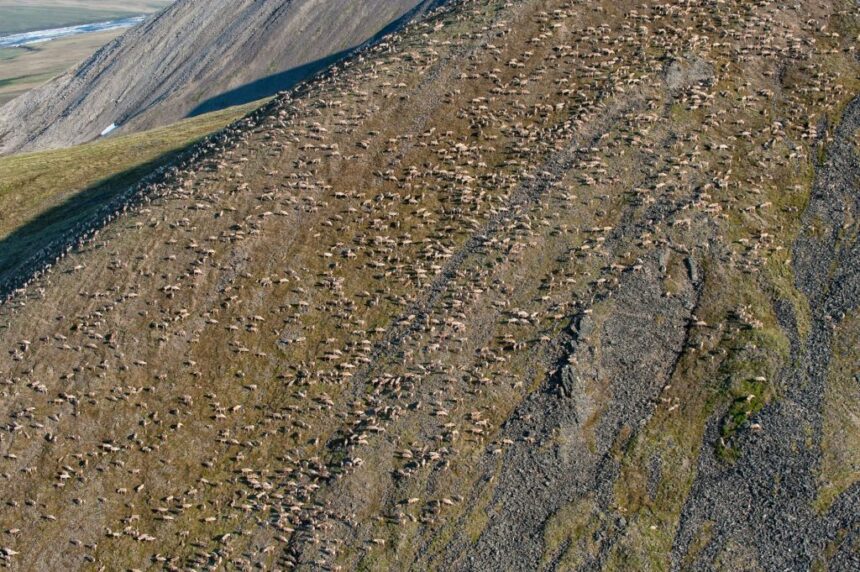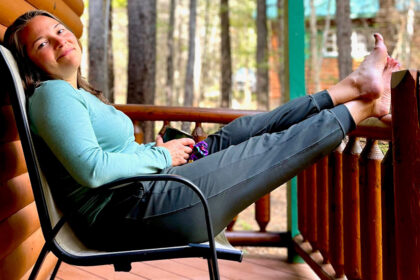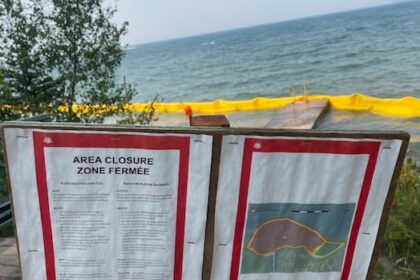In early July, Yukon and Alaskan biologists were waiting on a small miracle: the right conditions to summon an apocalyptic storm of mosquitoes. The biting insects, in turn, would drive tens of thousands of caribou into a massive herd, essential to making them countable from the sky. The phenomenon occurs every July, but photographing it from above to obtain a “photo census,” or population count, is a different story, Mike Suitor, a Whitehorse-based migratory caribou biologist with the Government of Yukon, says. Suitor, who has been advising on Porcupine caribou herd management since 2012, says witnessing the migration from a bird’s-eye view is difficult to put into words. “It’s like looking down at an anthill,” Suitor says. The spectacle is hard to look away from, but biologists have little time for awe. Flying in fixed-wing planes outfitted with digital cameras, they must capture clear, high-resolution images of the herd. Computer software stitches the images together so biologists can manually categorize every individual with a single dot. The software then sums up the dots and determines the population count. It is an undertaking that hasn’t succeeded since 2017, when researchers estimated the herd at 218,000 animals — the largest population recorded since monitoring began in the 1970s. Since then, climate change has further complicated the task. Shifting winds scatter herds into the mountains, where they’re exceedingly difficult to photograph, while smoke from increasingly frequent wildfires obscures the horizon. Some years, biologists can’t even get off the ground, let alone get the shot. Researchers have struggled to photograph and count the Porcupine herd since the last photo census in 2017, as the effects of climate change have scattered and obscured the animals. In July, they finally managed to. “It’s like looking down on an anthill,” Whitehorse-based caribou biologist Mike Suitor says. Photo: Peter Mather This year, the urgency was especially high. After seven years without an accurate population estimate, the Porcupine herd — one of the world’s last healthy migratory caribou populations — needed to be counted. The herd’s calving grounds in Alaska’s Arctic National Wildlife Refuge are currently at the centre of a decades-long fight over oil and gas development. Gwich’in communities on both sides of the border have warned industrial activity in the refuge will destroy the caribou. Despite this, Alaska’s state development agency is preparing to conduct 3D seismic testing there for the first time. “We know how critical [the photo census] is to communities right now,” Suitor says. With that in mind, biologists doubled the frequency of GPS signals from more than 110 radio-collared caribou — the small sample of the herd researchers collar to study the larger herd — and the Alaska team began flying daily patrols. Their persistence paid off. On July 10, the Alaska Department of Fish and Game announced that, thanks to a heat wave which fuelled the right conditions for mosquitoes to swarm and drive the caribou together, they had successfully photographed the Porcupine herd. Analyzing the images will take months, but Suitor says the achievement is a relief. Many signs suggest the herd is in decline — a disappointment, but not unexpected. The Porcupine caribou are one of the last remaining healthy caribou herds in North America, but their numbers seem to be declining. Photos: Peter Mather A recent study that analyzed DNA from caribou fossils dating back 21,000 years projected North American caribou populations could see average declines of 84 per cent by 2100, if the planet warms by two to three degrees Celsius. Should greenhouse gas emissions — created by the burning of fossil fuels — remain high, the Porcupine herd’s geographical range could shrink by 71 per cent. It’s a trend communities on the frontlines of global warming have noticed. The Vuntut Gwitchin First Nation of Old Crow, Yukon, live as cyclically as the Porcupine caribou herd they depend on — and they are just as sensitive to the changing seasons, deputy chief Harold Frost Jr. says. Over the past 20 years, the Vuntut Gwitchin have been living with the daily consequences of what Frost Jr. calls “drastic changes” in the climate. While most large migratory caribou herds in North America — including many in the Arctic — have declined due to pressures from roads and resource extraction, the Porcupine herd has remained relatively undisturbed by these threats. As a result, its numbers have stayed stable — and even grown. After falling to a low of 123,000 animals in 2001, the herd rebounded to a record high in 2017. Recently, however, there have been troubling signs. Reproductive rates among three-year-old females are dropping — often an early indicator that a herd is under stress — and fewer calves are surviving. Even more concerning is data from the 110 radio-collared caribou, most of them females. When a collar stops moving, biologists know the animal has died. Over the past year, only about 80 per cent of adult cows survived. “When you get below 86 per cent, you’re almost guaranteed you’re losing caribou within the herd,” Suitor says. “Climate change is a very significant factor. We hear it from the communities. We see it in the caribou and in their movements. And we’re seeing massive changes in some of these big migratory pathways.” The question for the Porcupine caribou herd now is: how steep will declines be? It’s not all bad news: Porcupine caribou herd represents a rare management success, biologist says Every year, the Porcupine caribou herd makes the longest land migration on earth, traversing more than 4,000 kilometres across tundra, mountains and rivers in the Northwest Territories, Yukon and Alaska to reach its calving grounds in Ivvavik National Park in northern Yukon and Alaska’s Arctic National Wildlife Refuge. Ivvavik, in Inuvialuktun, translates to “a place for giving birth, a nursery,” while the Gwich’in people call the Arctic Refuge Iizhik Gwats’an Gwandaii Goodlit — the sacred place where life begins. The Porcupine herd is unique for two reasons, Suitor explains. First, much of its range remains largely intact, spared from heavy development, with a few exceptions. Porcupine caribou traverse a mountainous plain in the Arctic National Wildlife Refuge, where they come to calve in the springtime. The Gwich’in people call the refuge Iizhik Gwats’an Gwandaii Goodlit — the sacred place where life begins. Photo: Peter Mather Second, the Porcupine herd was the first in North America to be formally managed through collaboration. The Porcupine Caribou Management Agreement was signed by the federal and territorial governments of Canada, Yukon and the Northwest Territories, and First Nations communities in 1985, followed by a 1987 treaty between Canada and the U.S. The herd is co-managed by Canada and the U.S., in collaboration with Indigenous communities. In this way, the Porcupine caribou herd represents a rare success, uniquely positioned to withstand the challenges ahead. “You need to have these strong partnerships to realize change, and I think the Porcupine caribou story has been a great narrative around that,” Suitor says, crediting decades of cross-border collaboration. Those partnerships are also facing threats as Indigenous and environmental organizations are gearing up for the next phase of the struggle against the U.S. administration’s agenda of drilling in the herd’s calving grounds in the Arctic Refuge. Laurence Fox, campaigns coordinator at the Canadian Parks and Wilderness Society’s Yukon chapter, based in Whitehorse, told The Narwhal the next phase of advocacy should be guided by Gwich’in communities, who’ve lived alongside the caribou for thousands of years. Vadzaih Choo Drin, or “Big Caribou Days,” is an annual festival held in the Gwich’in community of Old Crow, Yukon, celebrating the return of the migrating Porcupine caribou herd. This year’s festival was marked by sober discussions of new threats facing the herd. Photos: Michael Code / The Narwhal Fox points out how the U.S. administration is employing the rhetoric of “a national energy emergency” to move resource extraction projects forward with greater speed, which, they added, is not dissimilar to Canada’s push to pass Bill C-5. Both the U.S. and Canadian governments are attempting to speed up timelines on approving projects and moving major infrastructure and development plans forward. While protecting the Arctic Refuge from oil and gas development has been a decades-long struggle, Fox says “the rules of the game” have changed, especially under the current U.S. administration’s leadership. But no matter the gravity of what Indigenous and environmental organizations are up against, Fox says, it’s critical to move forward slowly and methodically. With this same principle in mind, Canada’s Porcupine Caribou Management Board has worked with Indigenous communities, governments, scientists and policymakers to safeguard the herd’s long-term health. “We’re always thinking ahead,” says Joe Tetlichi, chair of the Porcupine Caribou Management Board and a member of the Tetlit Gwich’in who lives in Whitehorse. “And the reason we’re thinking ahead is because back in the early 2000s, we watched the George River herd, the Bathurst and the Bluenose East and West all decline.” The disappearance of other barren-ground caribou herds in North America has been startling. For example, the Bathurst herd in the Northwest Territories plummeted from 470,000 in the mid-1980s to 6,240 today. These sharp declines motivated Tetlichi and the board, in close collaboration with Indigenous communities, to create a harvest management plan that sets clear rules that would limit the number or sex of caribou individuals are allowed to hunt if the population falls below certain thresholds. The plan includes a chart indicating herd status and hunting requirements with levels ranging from green (no restrictions for Indigenous communities, and some for other licensed hunters) to yellow, orange and red (more limited hunting to no hunting at all). Sharp declines in other barren-ground caribou herds in North America prompted the Porcupine Caribou Management Board to implement a strategy to limit hunting. When the herd is in the green zone, there are no limits for First Nations hunters, who can harvest for meat and hides, like those that Vuntut Gwitchin First Nation and Talhtan First Nation member Christine Creyke works on in Old Crow, Yukon. Photos: Michael Code / The Narwhal “We know we have no control over climate change, but we know we have control over harvesting,” Tetlichi says. Since the plan’s creation in 2010, the Porcupine caribou herd has consistently remained in the green zone. As a result, Tetlichi notes, the plan has never been put to the test. “If the herd ever goes down to 45,000 it’s not going to be easy to put our management plan at the plate,” he says, referring to the food security hardships the community would face and the uncertainty of compliance. Despite having a management strategy in place for the situation, the results would not be ideal. “It’s going to be tough, really tough.” Today, based on the photo census from 2017 and other indicators, the herd is considered stable. Licensed hunters can harvest up to two bulls, while Indigenous hunters face no limits. Still, Tetlichi stresses, the plan “covers bases” for the day when the population inevitably declines. “We’re taking the bull by the horns and moving forward for the sake of the well-being of the caribou,” he says. Mosquitoes and warble flies make caribou ‘go nuts’ Climatic shifts in the Porcupine caribou herd’s range are complex and interconnected, Suitor says. Warmer year-round temperatures are driving more frequent wildfires and increased vegetation growth. Heavy late-winter snowfalls can delay the herd’s migration to its calving grounds. Altogether, the landscape is changing rapidly, forcing the Porcupine caribou to adapt. “Deciduous vegetation [on the tundra] is growing taller and bushier, which isn’t ideal for migratory caribou that prefer lichen,” Suitor says. That has spinoff effects for attracting moose, which in turn increases wolf predation — and so on. Biologists are also asking: could increasing temperatures lead to increased insect harassment of the herd? Suitor’s team has a paper under peer review showing mosquito populations are peaking earlier. If this trend overlaps with calving and post-calving in June — when calves are still small and vulnerable — it could lead to increased mortality. And then there’s the worry about warble flies, bumblebee-sized insects that can travel hundreds of kilometres in search of caribou, buzzing and dive-bombing the herds. The flies lay their eggs in caribou’s fur on the animals’ legs and hindquarters. When the eggs hatch, the larvae crawl onto the caribou’s back, and burrow into their skin for the winter. In spring, they emerge as adult larvae, fall to the ground and the cycle begins again. Warble flies are more than just a nuisance to caribou herds — they burrow into the skin of the animals to lay their larvae, which can weaken caribou and leave them vulnerable to infections. Hide tanners have also noticed they leave pockmarks in the animals’ hides. Video: Government of Yukon / United States Geological Survey. Photo: Michael Code / The Narwhal “One warble fly can show up in a big herd of caribou and the caribou go nuts,” Suitor says. “They hate them. They can expend a ton of energy and during some parts of the summer they will choose habitats without food to try and get away from them, which can affect things like calving rates the next year.” Suitor and his team have been analyzing 70,000 video clips from collar-mounted cameras. The early results suggest warble fly populations, like mosquitoes, are also peaking earlier in the season — adding another layer of pressure. In the Northwest Territories, Indigenous hide tanners have also noticed an increase in hides affected by warble flies, who leave pockmark holes. Christine Creyke, a hide tanner and member of the Vuntut Gwitchin First Nation and Tahltan First Nation who lives in Old Crow, told The Narwhal in May she’s worried about the growing impacts of climate change on the herd. “When I’m working on my hides, I’m always thinking about the environmental changes happening to the caribou and how it’s affecting my work with traditional practice,” Creyke said. Changes to caribou migration mean big changes for the people who depend on them The Vuntut Gwitchin of Old Crow are already suffering the consequences of the collapse of another vital mainstay: Chinook salmon. Vuntut Gwitchin deputy chief Frost Jr. says the salmon have disappeared from the Porcupine River, a tributary of the Yukon River, forcing the community to adapt by relying more heavily on freshwater fish. In 2024, Canada and Alaska signed an agreement to establish a seven-year moratorium on Chinook salmon fishing in the Yukon River system. The loss of salmon intensifies concerns about climate and human-related pressures on the Porcupine caribou herd. Over the past 12 to 15 years, Frost Jr. explains, the community has observed major shifts in the herd’s migratory routes to their traditional wintering grounds south of Old Crow — changes that directly affect the Vuntut Gwitchin’s ability to access and harvest caribou. Instead of remaining in the Porcupine basin for the winter, he says, the herd is travelling farther north or east of Old Crow. During the rut, or mating season, in October, they are returning later than they did previously and staying for shorter periods. “[The caribou] are only here for two to three days and the men have to be ready to go hunt on the mountain,” Frost Jr. says. “Then [hunters] have to travel longer distances in the winter to wherever [the herd is] wintering at — that’s been a big change.” The Vuntut Gwitchin of Old Crow, Yukon have noted significant changes in the Porcupine caribou’s migratory habits over the last decade and a half. The animals are venturing farther north and east in the winter and returning to the community later in the fall and staying for shorter periods. These changes, in turn, impact the Gwitchin’s ability to hunt and harvest the animals. Photo: Government of Yukon / United States Geological Survey The changes people are witnessing are widespread, including record-breaking summer temperatures that fuel wildfires. In August 2023, residents of Old Crow — a fly-in community — were evacuated due to wildfire threats, including one that burned only kilometres away. The Porcupine River is freezing later in the fall and breaking up earlier in the spring, which disrupts the timing of the herd’s migration, Frost Jr. says. The community has also experienced more frequent rain-on-snow events in October and November, creating icy conditions. “It causes grief for the caribou because it’s harder for them to dig up their food under the snow,” Frost Jr. says. For the deputy chief there is no doubt: climate change is already inflicting grave consequences on the land, the animals and the community. The Vuntut Gwitchin continue to rely on traditional hunting and gathering practices — caribou, moose, muskrat, fish and berries — because store-bought food in their subarctic community is prohibitively expensive for many families. Their food security and survival depends on the longevity of vadzaih, the Gwich’in word for caribou. “We’re living here where [climate change] is affecting us — and the caribou — in real time,” Frost Jr. says, “not only physically, but mentally and emotionally.” Recent Posts Port of Montreal expansion plans put endangered fish found only in Quebec at risk Oct. 9, 2025 10 min. read The copper redhorse is on the brink of extinction. Its vital feeding grounds could be… In the Yukon, the longest land migration on earth is under threat Oct. 8, 2025 13 min. read Scientists are racing to count Porcupine caribou amid climate changes and ramped up pushes for… The AI data centre boom is here. What will it mean for land, water and power in Canada? Kevin O’Leary’s plans to build the world’s biggest data centre in a drought-stricken part of…
In the Yukon, the longest land migration on earth is under threat












